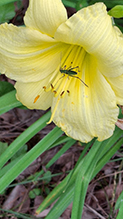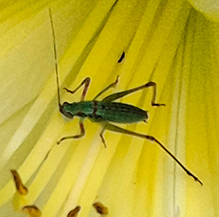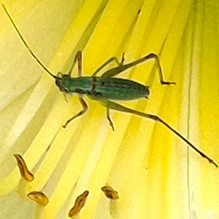fork-tailed bush katydid
(Scudderia furcata)
Conservation • Description • Habitat • Ecology • Distribution • Taxonomy
|
|
||||||||||||||
Description |
Fork-tailed bush katydid is a common, small, late season, leaf katydid. It is the most common and the most widespread katydid in the genus Scudderia. It occurs throughout the United States, southern Canada, and Mexico, but it is mostly absent from the Great Basin and the Rocky Mountains. Adults are active from July through October. They are found in trees and bushes and on forbs and coarse grasses, in meadows, fields, and thickets, and at woodland edges. They are found in both dry and marshy areas, but they are more common in marshy areas, especially in permanent marshes. Adults are small, one of the smallest katydids. Size of katydids is usually given in the literature in terms of male and female body length, length of the first segment of the thorax (pronotum), length of the wing covers (tegmina), and length of the hind femur. Overall size is rarely given. Male body length is ⅝″ to ¾″ (15 to 20 mm). Females are larger, with a ¾″ to 13⁄16″ (19 to 21 mm) body length. On both males and females, the tegmina length is 1″ to 1¼″ (26 to 32 mm), the pronotum length is 3⁄16″ (4.6 to 5.0 mm), and the hind femur length is ¾″ to ⅞″ (19 to 23 mm). The body is slender. In most of its range, adults are predominantly leaf green. The head, the underside of the body, and often the plate on the pronotum are yellowish green. In the south, the predominant body color is variable, and adults are categorized as green, red, pink, or brown forms. Throughout its range, adults usually exhibit more than one color, mostly leaf green with reduced patches of red, yellow, black, purple, brown, or white. The head is short. The top of the head (vertex) is somewhat rounded. The face is nearly vertical. The eyes are small and rounded. The antennae are hair-like and long, much longer than the body but not reaching beyond the end of the tegmina. They may be green, brown, or yellow, or they may be lighter at the base fading to darker on the outer three-quarters. They are attached high on the face and close together. The space between the antenna bases is less than the width of the first antennal segment. The pronotum is saddle shaped and short. The upper side is flat, the rear margin is broadly rounded, and the sides are parallel. The lateral lobes of the pronotum are bent downward at right angles to the top. They are flat and they are broadly rounded on the bottom. There is a longitudinal ridge (carina) in the middle, but it is faint and only on the rear half. The angles where the sides turn downward (lateral carina) are rather sharp. They are rarely yellowish. At the rear upper corner of each lateral lobe there is a concave depression (humeral sinus). The humeral sinus is narrow and deep. The tegmina are long and narrow, more than four times but less than six times longer than wide. They are longer than the body on both sexes. The margins are almost parallel, and the tip is broadly rounded. They are entirely green, including the part of the left tegmen that overlaps the right one. There are no black markings. The hindwings are longer than the tegmina. On the male, there is a rearward, upper extension of the last abdominal segment, a dorsal process called the supra-anal plate. The supra-anal plate is large, inflated, and deeply U shaped (forked). This is the feature that gives the species its common name, but it is not the only Scudderia species with this feature. The lobes of the fork are relatively short, almost cylinder shaped, and rounded above. They are widely separated at the tips. Below the genitalia, another plate-like structure, the subgenital plate, is conspicuous, long, Y-shaped, and arched upward. It is narrowed and compressed toward the end. On the female, the ovipositor is more than 1.5 times longer than the pronotum. It is relatively short for a katydid, but relatively large for a bush katydid. It is broad, and sword shaped. It is smoothly curved upward on the lower margin, curved upward and also abruptly bent upward on the upper margin. The legs are green. The front legs are short, the middle legs are a little longer, and the hind legs are much longer. On the hind legs, the fourth segment (tibia) is usually green, sometimes tinged purplish or brownish. With age, it fades to dull yellow or dull brown. The end part of each leg (tarsus), corresponding to the foot, has four segments. |
Size |
Male body length: ⅝″ to ¾″ (15 to 20 mm) Female body length: ¾″ to 13⁄16″ (19 to 21 mm) Tegmina length: 1″ to 1¼″ (26 to 32 mm) Pronotum length: 3⁄16″ (4.6 to 5.0 mm) Hind femur length: ¾″ to ⅞″ (19 to 23 mm) |
Song |
|
The song is very high pitched, about 15 kHz. It may be 1, 2, or 3 lisps per call, with a few seconds between calls. Males produce a rapid series of high-pitched ticks, when responsive females are present. Listen to fork-tailed bush katydid |
Similar Species |
Habitat |
Meadows, fields, and thickets, and at woodland edges |
Ecology |
Season |
One generation per year: July through October |
Behavior |
|
Life Cycle |
|
Larva Food |
|
Adult Food |
|
Distribution |
||
|
Sources Orthoptera Species File GrylTett Database, content by Tom Walker (2016) Hebard, Morgan. (1932). The Orthoptera of Minnesota. University of Minnesota. Minnesota Agricultural Experiment Station. Retrieved from the University of Minnesota Digital Conservancy, https://hdl.handle.net/11299/204015. |
|
| 9/7/2024 | ||
Occurrence |
||
Common and very widespread |
||
Taxonomy |
|
Order |
Orthoptera (grasshoppers, crickets, and katydids) |
Suborder |
Ensifera (katydids, crickets, and allies) |
Infraorder |
Tettigoniidea (katydids, wētā, and allies) |
Superfamily |
Tettigonioidea |
Family |
Tettigoniidae (katydids) |
Subfamily |
Phaneropterinae (leaf katydids) |
Tribe |
Scudderiini |
Genus |
|
Subordinate Taxa |
|
fork-tailed bush katydid (Scudderia furcata furcata) fork-tailed bush katydid (Scudderia furcata furcifera) fork-tailed bush katydid (Scudderia furcata sinaloae) |
|
Synonyms |
|
|
|
Common Names |
|
fork-tailed bush katydid |
|
Glossary
Ovipositor
A tube-like organ near the end of the abdomen of many female insects, used to prepare a place for an egg and to place the egg.
Pronotum
The exoskeletal plate on the upper side of the first segment of the thorax of an insect.
Subgenital plate
In male Orthoptera, the plate-like structure extending from the lower (ventral) side of the end of the abdomen underlying the genitalia.
Tarsus
On insects, the last two to five subdivisions of the leg, attached to the tibia; the foot. On spiders, the last segment of the leg. Plural: tarsi.
Tegmen
The modified, leathery front wing of grasshoppers and related insects that protects the hindwing. It may also serve as a camouflage, a defensive display, or a sound board. Plural: tegmina.
Tibia
The fourth segment of an insect leg, after the femur and before the tarsus (foot). The fifth segment of a spider leg or palp. Plural: tibiae.
Vertex
The upper surface of an insect’s head.
Visitor Photos |
||
Share your photo of this insect. |
||
This button not working for you? |
||
Luciearl |
||
Insect on daylily. It appeared this insect was going to spend the night on the daylily. Checked on him over a few hours and was still there. |
||
 |
 |
|
 |
|
|
Dan W. Andree |
 |
Katydid on Goldenrod... Seen it at Frenchman’s Bluff SNA 8-29-24. |
Alfredo Colon |
||
 |
 |
|
 |
||
MinnesotaSeasons.com Photos |
||
|
||
|
||

Slideshows |
|

Visitor Videos |
||
Share your video of this insect. |
||
This button not working for you? |
||
|
Other Videos |
||
Scudderia furcata |
About
Oct 4, 2019 Kingdom: Animalia Scudderia furcata is a species in the family Tettigoniidae, in the order Orthoptera. A common name for Scudderia furcata is "fork-tailed bush katydid". The distribution range of Scudderia furcata includes Central America and North America. |
Scudderia septentrionalis, male singing on my hand. |
About
Dec 6, 2016 uly 22nd 2016. |
Fork Tailed Bush Katydid | Scudderia Furcata | Backyard Nature |
About
Jul 29, 2024 |
Fork-tailed Bush Katydid - Female (Scudderia fucata) |
About
Oct 14, 2016 Filmed on a chilly, windy, October day in Missouri. Otherwise, she wouldn't have let me get so close. Grasshoppers, Crickets, Katydids (Orthoptera) » Long-horned Orthoptera (Ensifera) » Katydids, Camel Crickets, and relatives (Tettigoniidea) » Katydids (Tettigoniidae) » Phaneropterine Katydids (Phaneropterinae) » Bush Katydids (Scudderia) » Fork-tailed Bush Katydid (Scudderia furcata) Music: Third Time |

Visitor Sightings |
||
Report a sighting of this insect. |
||
This button not working for you? |
||
| Luciearl 7/25/2025 |
Location: Lake Shore, MN It appeared this insect was going to spend the night on the daylily. Checked on him over a few hours and was still there. |
 |
Dan W. Andree |
Location: Frenchman’s Bluff SNA |
 |
Alfredo Colon |
Location 1: Albany, NY |
 |
Alfredo Colon |
Location: Albany, NY |
 |
Alfredo Colon |
Location 1: Albany, NY |
 |
MinnesotaSeasons.com Sightings |
||
|

|
Created: 9/8/2024 Last Updated: © MinnesotaSeasons.com. All rights reserved. |

